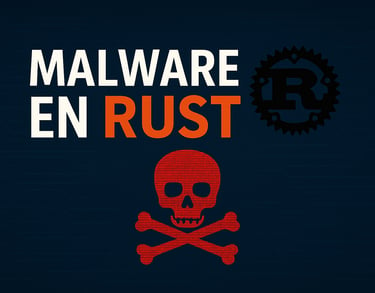Understanding Rust Malware: What You Need to Know
Rust is quickly becoming a popular programming language for many applications and yes, that includes malware development. Why? Because Rust combines the performance of low-level languages like C++ with strong safety guarantees. This makes it an attractive choice not only for legitimate software but also for threat actors looking to build efficient, stealthy malicious programs.
ARTICLES


Introduction
Rust has rapidly emerged as a modern programming language that combines speed, safety, and low-level control. But this power has also caught the attention of malicious actors who leverage Rust to create more effective and stealthy malware. Unlike traditional languages like C or C++, Rust eliminates common memory errors that often make malware unstable or easier to detect. This robustness, combined with its ability to target multiple operating systems, makes Rust a formidable tool in attackers’ arsenals.
In this article, we’ll explore why Rust’s very nature makes its malware particularly dangerous, how blue teams can prepare to defend against it, and how pentesters can ethically harness Rust to strengthen security.
Real-World Examples of Popular Rust Malware
Zebrocy (APT28 Group): A sophisticated malware used in cyber espionage campaigns, with some components written in Rust to enhance stealth and stability.
Satori Botnet (IoT): A botnet targeting IoT devices, with Rust implementations to boost propagation speed and code resilience.
RustyBuer (Spyware): Malware developed in Rust targeting Windows environments, known for evading detection through language-level optimizations.
These examples highlight Rust’s growing role in the threat landscape and underscore why understanding this language is vital for cybersecurity professionals.
Why Rust’s Nature Makes Malware More Dangerous
Memory Safety Without Performance Loss
Unlike C or C++, Rust prevents common bugs like buffer overflows, use-after-free, and null pointer dereferencing at compile time. This means malware written in Rust is less likely to crash or expose itself through memory errors, making it more stable and stealthy.Fine-Grained Control of System Resources
Rust gives low-level access to hardware and operating system features, letting malware perform advanced tricks (like hooking system calls or manipulating processes) with high efficiency.Modern Tooling and Ecosystem
Rust’s rich libraries and package manager enable rapid development and easy reuse of code — speeding up malware creation and making complex attacks easier to build.Cross-Platform Compilation
Rust binaries can target Windows, Linux, and macOS easily, increasing malware’s reach and adaptability.
what it looks like
For Blue Teams: How to Defend Against Rust Malware
Understand Rust to Stay Ahead
Rust malware often slips past traditional defenses because it avoids common vulnerabilities like buffer overflows and memory corruption. Its binaries are usually compact, optimized, and harder to analyze.Upgrade Your Detection Tools
Antivirus and EDR solutions need to recognize Rust executables and analyze their signatures and behaviors using dynamic analysis and machine learning.Train Analysts in Rust Reverse Engineering
Security teams should master tools like Ghidra, Radare2, or IDA Pro, which can handle Rust’s unique characteristics, such as name mangling and memory management patterns.Focus on Behavior, Not Just Signatures
Since Rust malware can easily change code while keeping behavior intact, rely on behavioral detection monitoring suspicious file creation, network activity, and persistence mechanisms.
For Pentesters: Using Rust for Ethical Testing
Build Educational Malware
Writing Rust programs that mimic malicious behaviors (persistence, data collection, exfiltration) helps teams understand attack methods and trains blue teams effectively.Test Modern Systems’ Resilience
Rust malware can be deployed to simulate stealthy attacks on secure environments, testing real-world defenses without unnecessary noise.Leverage Rust’s Power and Safety
Rust lets you write low-level, high-performance code while minimizing memory errors that could skew your test results.Share Open-Source Tools and Code
The security community thrives on collaboration sharing Rust-based educational malware fosters better cooperation between pentesters and defenders.
Conclusion
Rust is reshaping cybersecurity making malware more efficient, stealthy, and cross-platform. Blue teams must upgrade their skills and tools to detect these threats, while pentesters should responsibly use Rust to build powerful, ethical testing tools.
For those interested, I have created a simple Rust malware example available on my GitHub to explore and learn from: https://github.com/Jka667/Simple-Rust-Malware-Code-
Feel free to check it out and contribute!



